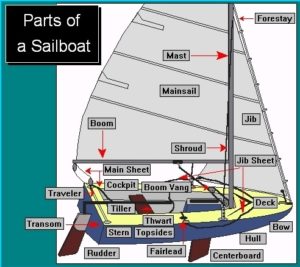You can learn to sail fast, and quickly at that. Here are five ways, graduating from easy to intermediate.
Adventure Cruise
 Couples and families who book an Adventure Cruise with Let’s Go Sail get a chance to run the helm over a comfortable course spanning three hours. In so doing, they get sufficient tips and pointers to get the drift of sailing. Before long, they pick it up intuitively. Sailing is one of the few sports that is easy to learn, provided the boat is big enough and the wind sufficient. Note: Lessons are informal and non-certified, taught by a USCG captain and certified sailing instructor.
Couples and families who book an Adventure Cruise with Let’s Go Sail get a chance to run the helm over a comfortable course spanning three hours. In so doing, they get sufficient tips and pointers to get the drift of sailing. Before long, they pick it up intuitively. Sailing is one of the few sports that is easy to learn, provided the boat is big enough and the wind sufficient. Note: Lessons are informal and non-certified, taught by a USCG captain and certified sailing instructor.
Lessons Cruise
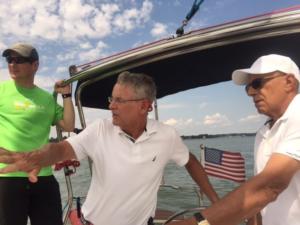 Let’s Go Sail offers a specific three-hour block to teach the basics. Learn the aerodynamics of sailing. Differentiate the three sail “reaches” for power. Learn how to “see” the wind. Find out how to rescue a man overboard quickly. Try your hand at marine radio. You can learn to deploy the spinnaker sail when going downwind. It’s informal and a lot of fun. Guests who enjoy this package often move up to the next level or go out and buy a boat for themselves. Lessons are informal and non-certified. People come back two or three times to learn as much as they can in a fun setting without pressure.
Let’s Go Sail offers a specific three-hour block to teach the basics. Learn the aerodynamics of sailing. Differentiate the three sail “reaches” for power. Learn how to “see” the wind. Find out how to rescue a man overboard quickly. Try your hand at marine radio. You can learn to deploy the spinnaker sail when going downwind. It’s informal and a lot of fun. Guests who enjoy this package often move up to the next level or go out and buy a boat for themselves. Lessons are informal and non-certified. People come back two or three times to learn as much as they can in a fun setting without pressure.
Adventures in Sailing
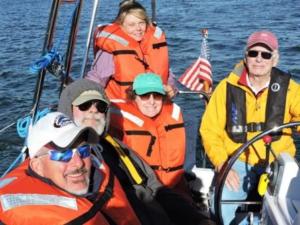 For 20 years, the Williamsburg Area Learning Tree has underwritten a community class where people learn to sail over three Saturdays or Sundays in the fall and spring. Official USCG life preservers are included. Up to six people spend six hours each day going through various drills to learn how to sail. The class is as much social as educational, and it’s a great orientation for couples. (The entire curriculum of WALT was suspended in 2019 for lack of a sponsor, but efforts are underway to revive the program and with it the sailing instruction.)
For 20 years, the Williamsburg Area Learning Tree has underwritten a community class where people learn to sail over three Saturdays or Sundays in the fall and spring. Official USCG life preservers are included. Up to six people spend six hours each day going through various drills to learn how to sail. The class is as much social as educational, and it’s a great orientation for couples. (The entire curriculum of WALT was suspended in 2019 for lack of a sponsor, but efforts are underway to revive the program and with it the sailing instruction.)
Sailing Made Easy
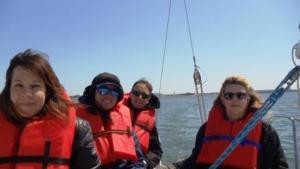 This is the basic 101 class offered by SailTime Virginia Beach under the American Sailing Association. The class runs two days on a weekend, with an hour or so in the morning for classroom instruction. That’s followed by the rest of the day on inlet waters of Chesapeake Bay in a 22-foot Capri. Instructors are USCG captains and ASA certified. Certification enables sailors to use the Capri fleet at their convenience with a SailTime membership. If you learn to sail this way, it becomes a great alternative to buying a boat. Visit sailtime.com/virginia-beach/.
This is the basic 101 class offered by SailTime Virginia Beach under the American Sailing Association. The class runs two days on a weekend, with an hour or so in the morning for classroom instruction. That’s followed by the rest of the day on inlet waters of Chesapeake Bay in a 22-foot Capri. Instructors are USCG captains and ASA certified. Certification enables sailors to use the Capri fleet at their convenience with a SailTime membership. If you learn to sail this way, it becomes a great alternative to buying a boat. Visit sailtime.com/virginia-beach/.
Basic Coastal Cruising
This is the next level of ASA, 103. The coursework is more detailed and the scope is larger. Classes are held in the morning and are followed by outings in Chesapeake Bay on Hunter 36 boats. Certification calls for an overnight cruise from Norfolk to Cape Charles or Hampton so sailors can learn basic navigation and docking. Visit sailtime.com/virginia-beach/.
Nomenclature
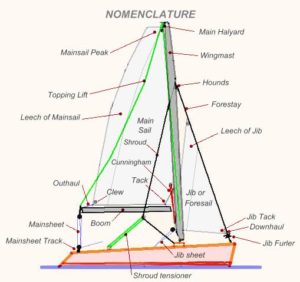 One of the most vexing things to newbies is the nomenclature. People think it’s a snobbery thing, but it isn’t. Every function and part has a name, for good reason. If the boom is about to swing across and hit someone in the head, it’s fine to yell “Duck!” and they’ll get the idea. But if someone falls overboard and you yell, “MOB on the right,” confusion immediately sets in as to whose right, the caller or the skipper’s. That’s why the boat has a starboard side and a port side, from the view of the skipper behind the wheel. There is only one port side, and it is easy to remember because it has four letters just like left. There’s a lot of that when you learn to sail.
One of the most vexing things to newbies is the nomenclature. People think it’s a snobbery thing, but it isn’t. Every function and part has a name, for good reason. If the boom is about to swing across and hit someone in the head, it’s fine to yell “Duck!” and they’ll get the idea. But if someone falls overboard and you yell, “MOB on the right,” confusion immediately sets in as to whose right, the caller or the skipper’s. That’s why the boat has a starboard side and a port side, from the view of the skipper behind the wheel. There is only one port side, and it is easy to remember because it has four letters just like left. There’s a lot of that when you learn to sail.
The nomenclature combines derivative descriptions with folklore. The boom is certainly well named when it hits you. The running rigging refers to movable lines (called sheets, don’t ask why). The standing rigging refers to the cables that hold up the mast. They’re standing up, get it?
Lights
 Either by design or default, sailors eventually wind up on the water out at night. It’s not recommended for newbies because there are so many obstacles, especially crabpot lines. As dusk descends, boaters are required to turn on their running lights, so named because they indicate you’re moving. If you’re anchored out, switch to the anchor light, which is a 360-degree white light at the top of the mast. Never run the anchor light with the running lights at the same time because that will just confuse people.
Either by design or default, sailors eventually wind up on the water out at night. It’s not recommended for newbies because there are so many obstacles, especially crabpot lines. As dusk descends, boaters are required to turn on their running lights, so named because they indicate you’re moving. If you’re anchored out, switch to the anchor light, which is a 360-degree white light at the top of the mast. Never run the anchor light with the running lights at the same time because that will just confuse people.
 The running light protocol is ingenious because the colors convey the direction of a nearby boat. Look closely at this illustration of red-green-white. The bowlight is red and green. Boaters who see a red light moving in front of them should realize the other boat is proceeding from right to left, perhaps across our bow. We need to take action to deviate. Similarly, a boat moving from port to starboard across our bow shows a green bowlight. Again, get ready to deviate. If you see the white light, it means we’re proceeding from behind to overtake the boat. You will never see all three lights at once; that’s the genius of the system.
The running light protocol is ingenious because the colors convey the direction of a nearby boat. Look closely at this illustration of red-green-white. The bowlight is red and green. Boaters who see a red light moving in front of them should realize the other boat is proceeding from right to left, perhaps across our bow. We need to take action to deviate. Similarly, a boat moving from port to starboard across our bow shows a green bowlight. Again, get ready to deviate. If you see the white light, it means we’re proceeding from behind to overtake the boat. You will never see all three lights at once; that’s the genius of the system.
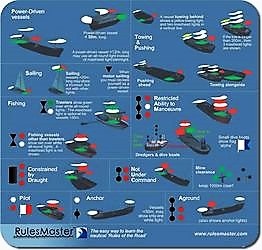 As it happens, different boats have discrete lighting motifs so that you can tell them apart. It’s very useful to identify a tugboat from a freighter at night, especially if you’re close to it and about to get run over. The protocol looks complicated, and it is. The basic Captain’s Course at nearby Chesapeake Marine Training Institute spends many hours teaching the lighting protocols. Come testing, students are required to differentiate the boats by light in less than 2 seconds as the patterns stream past on a computer. For those who are skittish, this is one more reason not to sail at night. But you never know when you might be out there on someone else’s boat, and they have no idea.
As it happens, different boats have discrete lighting motifs so that you can tell them apart. It’s very useful to identify a tugboat from a freighter at night, especially if you’re close to it and about to get run over. The protocol looks complicated, and it is. The basic Captain’s Course at nearby Chesapeake Marine Training Institute spends many hours teaching the lighting protocols. Come testing, students are required to differentiate the boats by light in less than 2 seconds as the patterns stream past on a computer. For those who are skittish, this is one more reason not to sail at night. But you never know when you might be out there on someone else’s boat, and they have no idea.
Drinking
 Finally, it’s good to know what the DUI laws are on the water. They are basically the same as for driving a car. Drivers suffer impaired judgment and reduced reaction time, just like on the highway. What’s different is that unlike car drivers, boaters lean toward greater self-confidence just when their attention span has been shortened. What the hell, they think, this is fun!
Finally, it’s good to know what the DUI laws are on the water. They are basically the same as for driving a car. Drivers suffer impaired judgment and reduced reaction time, just like on the highway. What’s different is that unlike car drivers, boaters lean toward greater self-confidence just when their attention span has been shortened. What the hell, they think, this is fun!
Drinking happens frequently at night, precisely when a shortened attention span can be deadly. Many accidents occur as boaters slam into fixed buoys. BUI is worse for motorboaters than sailors because the former tend to crank up the speed at night, when they should slow down instead.
The video below shows the basics of sailing, turning the boat into the wind to achieve the ideal close reach with the wind at a 45 degree angle. That’s all there is to it. Simply maneuver the boat to gain that 45 line. It’s the ideal angle for the fastest point of sail. The boat will heel 15 degrees in a brisk wind and you will be a sailor.
Let’s Go Sail
Check rates and pick a day for a sailboat charter. See reviews on Trip Advisor from sailors like you.
